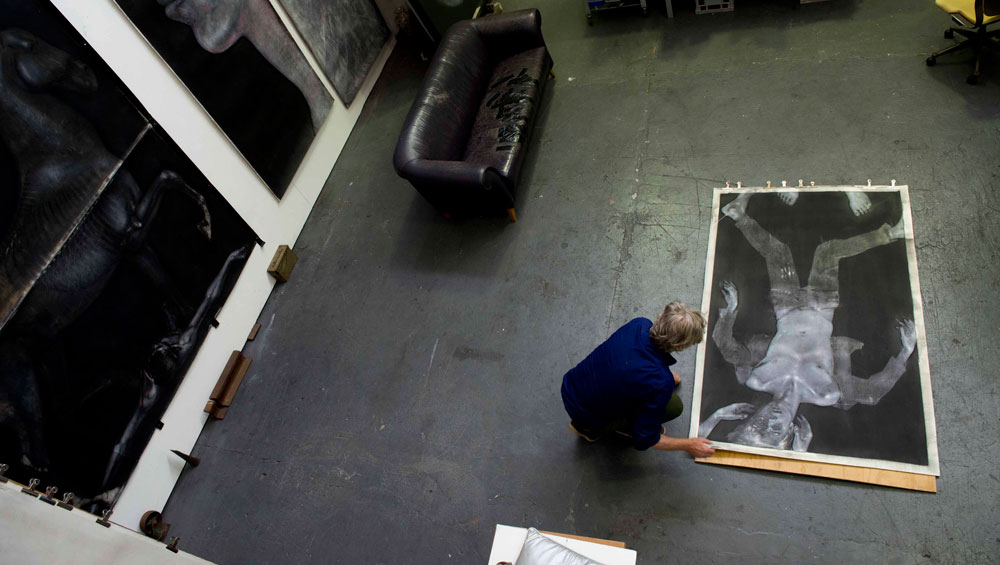
by JANET McKENZIE
For almost 40 years Godwin Bradbeer, who was born in 1950 in New Zealand, but now lives and works in Melbourne, Australia, has concentrated exclusively on large-scale drawn images of the human form. During that period the prospectus for drawing and all forms of the visual arts has shifted dramatically. Although figurative, his works can insinuate ideas and views on other aspects of art, including the performative, conceptual and abstract. In his vast enigmatic works, Bradbeer’s intent and ideas remain inscrutable, locked within an undeniable technical proficiency. As a young artist, he rejected modernism and had an adolescent desire to shock, and the overriding message of his work has been to excel in formal terms and to attempt to attain beauty in the visual arts. Having also taught drawing in schools and art schools, he claims that drawing in most manifestations possesses an inherent modesty in manner and purpose.
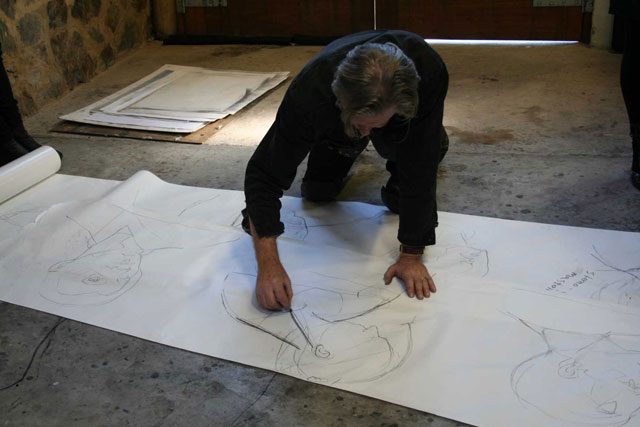
Godwin Bradbeer teaching, 2014. Photograph: Emmy Mavroidis
Janet McKenzie: What precipitated your shift from photography to large-scale drawing in the late 1970s?
Godwin Bradbeer: My need to draw predated my need to take photographs. The issue of scale was secondary to other concerns. The authorship (of artist) and anonymity (of subject) were the critical issues and were substantially denied to me in photography. If I wanted to venture deeply into the domain of the human entity, the subject should not be a vulnerable individual man or woman, and the artist – the self – had to accept the full responsibility for its making and its expressed character.
Voyeurism and appropriation – the strategies of pop practice and to some extent photography – would (or to put it more kindly “could”) trivialise and vulgarise my intention. That said, I still had to negotiate difficult realms of human experience. Had I not done that, I would have felt that I was examining the self from the periphery rather than from the generative core and centre of being.
Working on a large scale was necessary to my process for several reasons. I wanted the drawings to have equivalent physical presence. I would even cast my own shadow on to the surface and draw my subject – man or woman – into my own shadow and, in so doing, I literally stepped into the earliest mythology of the origin of drawing. The drawing now is not simply a picture, it has both ghost and materiality, and whether beautiful or un-beautiful, its presence might indeed be discomforting.
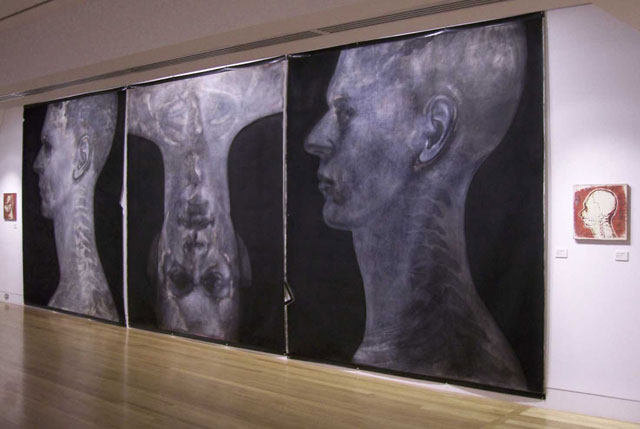
Godwin Bradbeer. Empirical Triptych, 1983. Chinagraph, silver oxide, charcoal and pastel on paper. Also included are Cosmetic Profile 1 and 2, 1984. Enamel paintings on linen. Installation at Shepparton Gallery. Photograph: David Senior.
JMcK: Your amplification of the head in Empirical Triptych (1983) makes it a spectacular work. What were you trying to achieve with that work that you had not embarked on before?
GB: It is possible that my adolescent years of daring lasted too long. Boys and men have years of daring mixed with stupidity. I was not in a sports team, or a rock band; I was not even partying. I wasn’t going to skydive or bungee jump, so I took on very presumptuously a conflation of fragility with grandeur, of myself with Rameses’ erect head from Egyptian sculpture and the profile from his disembalmed corpse and the bewildered distant gaze of the Easter Island edifices. There was also something of Shelley’s poem Ozymandias … “My name is Ozymandias, King of Kings …” Empirical Triptych might be a crucifixion or it may simply be a mugshot.
JMcK: Your career has been mostly devoted to the drawn image with a unique method using chinagraph, silver oxide and pastel. What led you to develop this method?
GB: In the 70s, I experienced what, for me, was a quantum leap in engaging the human figure in my art. Several factors collided that, taken together, demanded a new and brazen attitude and manner. The rising need for me was that the work must have both physical presence and an enigmatic residual beauty. A curious process emerged from my experimental recklessness in the mid-70s. By endeavouring to create a radiant white within a drawing, I used a medium ignored by artists though frequently used by ceramicists, tilers and glaziers. These were Chinagraph pencils (made then by Staedtler) and designed for drawing on glass and china. Chinagraph is waxy and thick, will draw over anything and is very slightly translucent. It permitted broad dynamic gesture and quite wonderfully – when describing flesh – rather than illustrating body it actually looked like it was body itself. I felt I had found a halfway point between painting and drawing.
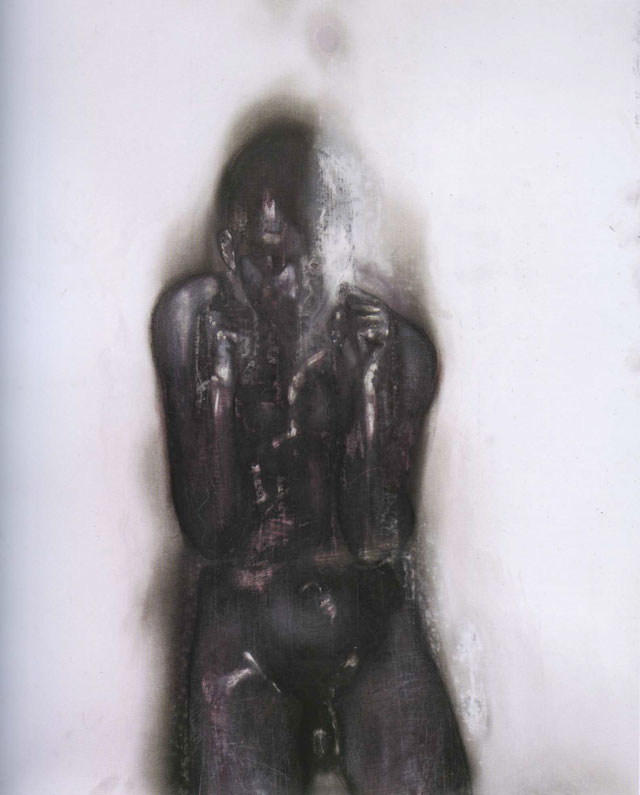
Godwin Bradbeer. Man of Paper V11, 1995-98. Chinagraph, silver oxide and pastel. Collection: Art Gallery of NSW.
Then one day in 1974, after stirring sugar into my tea, I carelessly rubbed the silver spoon against the white chinagraph profile that I was drawing and the burnishing cast a very slight metallic sheen across the white but, more remarkably, the silver oxide blackened the edges of the drawing and the profile “popped” into illusory relief, precisely like the solarised photographs of Man Ray. Warren Breninger, my brother Jamie and I had been solarising our darkroom prints for years and now I had found an equivalent within another medium. From this point onwards, I realised I wanted my work to be, or appear to be, emergent from mineral elements rather than from colourful quality “art” products.
This was now a kind of alchemy and the novelty of the discovery did not wear off. I had begun at this time doing extensive anatomical foundation drawing for my figures and I began filling all skeletal structure with thick white chinagraph, which I then burnished with electroplated nickel silver (EPNS) spoons. The burnishing created a counter movement within the gesture of the drawing and brought a mineral sheen to the bone. I would crush many pastels to powder (usually pink and ochre) and rub the dust into the zone of the flesh. I would then conceal my entire figure – usually life size or larger – under another layer of dense alabaster white chinagraph. This then became a drawing of a man into which you might sometimes see, but possibly also feel his interiority. Photo-realism, internationally popular at the time, did not permit this. Aside from my friend Warren, I knew absolutely no precedent for a process or imagery or an intention like this in drawing anywhere, then or now.
In the next phase of drawing, circa 1979, I found that my multilayered drawing could be stripped of sections of the top layer and the initial under layer remained unaltered and indelible. I could move forward and backward within the drawing. I would now take large chinagraph compositions off the wall and on the studio floor. I would pour crushed black pastel and studio dust on to my drawings to entirely conceal them. Then back on the wall these Rothko/Reinhardt-like black abstractions could be cleaned, unveiled of their blackness, polished and returned to visibility like sparkling archaeological objects.
I could if I wished build, erase, violate and retrieve my drawing almost indefinitely on this bizarrely developed structure.
In later years, I stopped working with the anatomical under drawing and I prefer now to draw dense solid white under drawing. The irony, indeed the paradox, is that for all the darkness of my drawings they are drawn primarily in a white that eventually emerges in the warm and cool tones of ivory and alabaster.
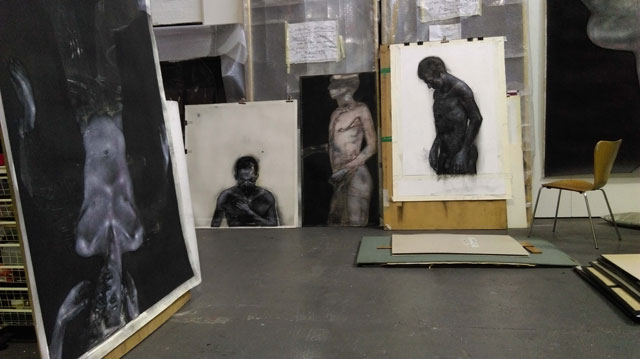
Studio photograph, 2017. From left: The Lodger, 2014; Oath, 2011; Breathing Man, 1980; One Man, 2016. Photograph: the artist.
JMcK: The teaching of drawing has occupied an important place in your career as an artist specifically teaching life drawing at a time when abstract art and conceptual forms of art were in the ascendancy. How does a young artist (or an artist of any age, for that matter) benefit from drawing the figure?
GB: Self-comprehension and acknowledgement of our shared and mutual finite dimensionality is at the heart of drawing from ourselves and from others. It is a pretty sound place to begin the journey into the infinite mysteries of art.
Although I engage such classes initially as a perceptual experience, a conceptual intention – or its bathetic opposite – emerges from the event whether consciously or unconsciously. Contemplating and describing the human subject is as banal and as magnificent as we perceive ourselves to be.
My conviction about the importance of life-drawing was deepened when I realised how vulnerable and rudderless so many young artists were and how susceptible they were to persuasive ideology from a revered art-world intelligentsia and an irresistible marketplace.
When I refer physiological information to my students – in speech, diagram, demonstration or the accomplishment of others – I insist that my information is not foreign to them: it is known to them, in the muscle memory of their fingers as they bathe, caress and inhabit the human body. Life drawing is very humbling for all participants; it is best to recognise this at the outset. The students, artists and tutor are more naked than the subject, whether the model is clothed or unclothed. There are several degrees of nakedness in this context. Usually, life classes are easel based so the work confronts us head on, we are exposed to ourselves and each other unshielded by partitions, we are in situ without the protection of text and technology, and we behold a naked person whom we recognise as a physical variation of ourselves. I understand that many people might wish to shrink from this, but it presents a base reality – rather than a theory or a construct – that can give foundation to any practice, whether perceptual, conceptual, formal or even subversive.
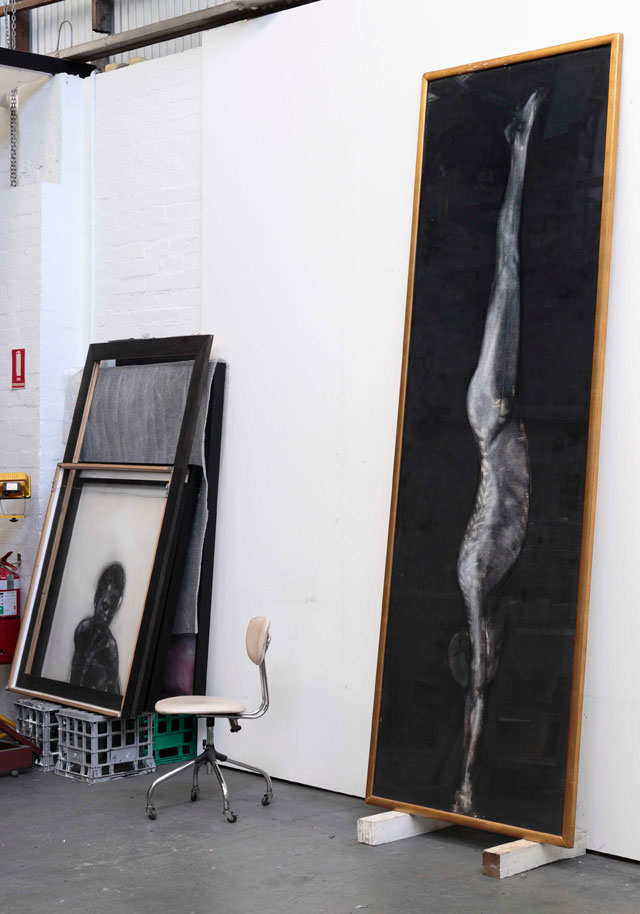
Godwin Bradbeer. Fall, 1981, in studio 2016. Chinagraph, silver oxide, pastel and charcoal. Collection of the artist. Photograph: Julian di Stefano.
Accomplished students are invariably hypercritical of their own work. I move in and out of performance and encourage students to move between objectivity and subjectivity by movement backwards and forwards. I do several things that for my generation of academics were considered very uncool. I demonstrate. An aspect of the way I do this is critical; I do it on my hands and knees. I draw on roll paper – and sometimes on concrete – on the floor. I never demonstrate standing up or sitting. My experience has shown me – and I can only reveal this now that my career is behind me – that closed, defensive or cynical students will open up to information imparted from a teacher on his knees beneath them far more willingly than to a standing, didactic pedagogue. I demonstrate and deliver information to help students get out of trouble, never as a command.
JMcK: Has your choice of the human form in art made you feel marginalised in the art world?
GB: The vaunting claim of contemporary art for many decades was that it was most emphatically not a narrative: it was art itself. As indigenous voices have arisen, requiring and demanding that they be able to “tell their stories”, western artists have become less adamant that they have nothing to say.
I recognised what was very obvious in my early years – that, although contemporary painting and drawing was largely abstract (and non-narrative), contemporary photography and film was figurative (and narrative). Why should the medium determine and prohibit the conceptual vision? Perhaps it was for this reason that the photography I exhibited in the 70s (with Warren Breninger) in fact received a lot of press commentary. Ironically, it is subsequent curators who have marginalised that work.
JMcK: Your stated influences include Francis Bacon (1909-92), and Alberto Giacometti (1901-66). How does their worldview inform your work?
GB: It is perhaps very difficult for the current generation to comprehend how contraband figuration was to the critical elite for much of the 20th century. I always felt that Giacometti managed to slip through because he was so thin and Francis Bacon because he was so brutal. I would regard the language – in discourse and in work – of these artists as existentialist and I found this somewhat ironically to be compatible with the stark Protestantism of my youth. These artists provided a way forward for me, but of course Giacometti was perhaps too constrained and Bacon too abandoned for strict emulation.
JMcK: Your survey exhibition Stigma and Enigma, at the Deakin University gallery in Melbourne earlier this year, highlighted a number of important aspects of your career. What does the title evoke or refer to?
GB: I tend to use titles that serve as a caveat, even a caveat emptor, cautioning visitors that they may not like what they see.At the time of determining the title, the theme of the retrospective show was going to be largely sustained by works that carried either actual or symbolic damage. The germinal intention was to “pitch perfect against imperfect” as you have described it yourself, so for this reason many of the works bore the mark of the negative, of a stigma. Regarding enigma, I recognise how earnestly I try to comprehend and articulate the work I make. But I do have to admit that an aspect of that work, perhaps the greater portion, is something enigmatic by nature, a mystery not least to myself.